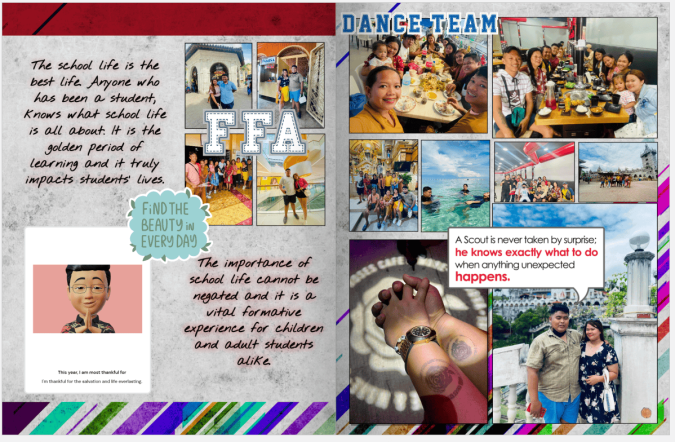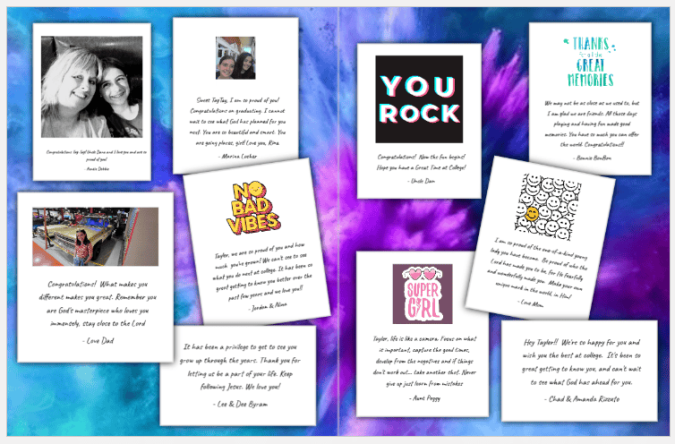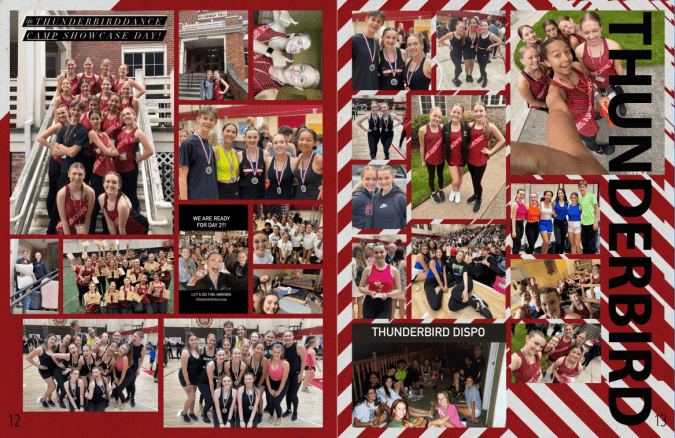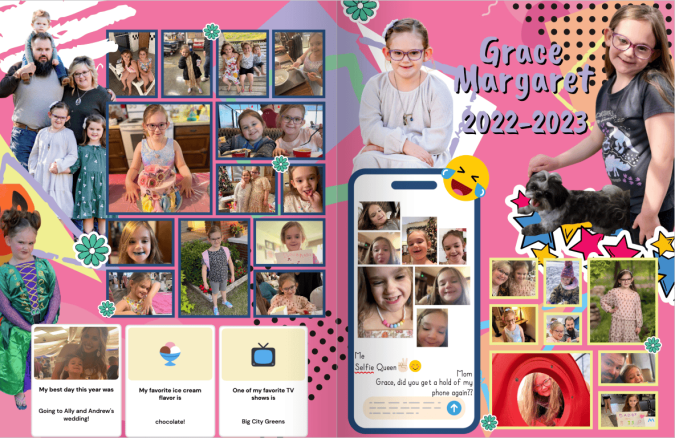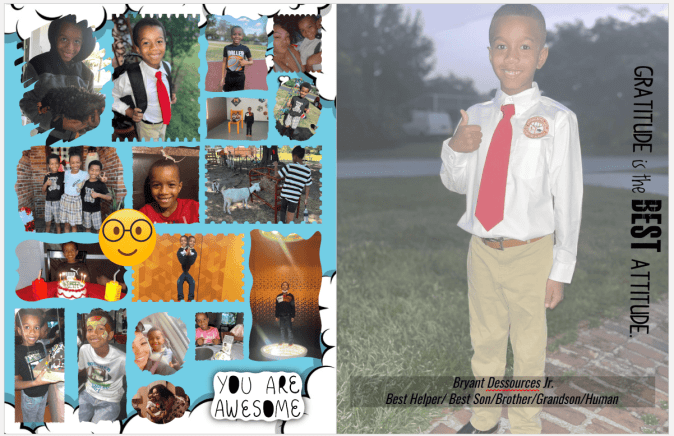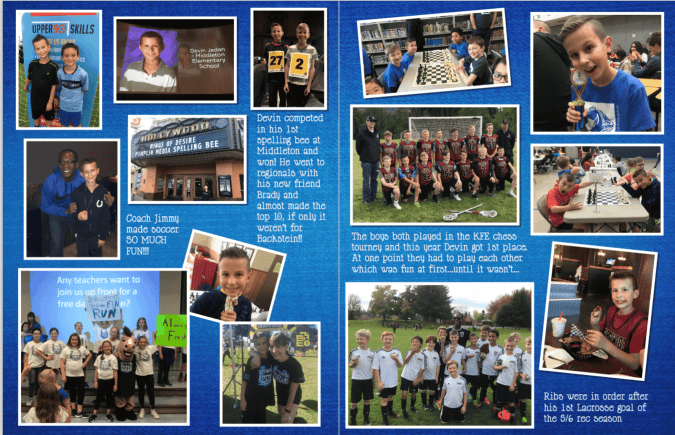Coverage tips
Looking for inspiration, design tricks, how to make a great cover, promoting your yearbook and engaging your community?
Most recent

Why you need evergreen content for yearbook
Like its namesake, evergreen content stays fresh for a long time, unlike the tie-dye loungewear we are still trying to forget. While you should definitely include polls and trends in your yearbook (it is the story of the year after all), open-ended interview questions (such as the 40+ we are giving you below) should remain in your repertoire for three reasons:
For ease of use, we organized these interview questions by yearbook section. Grab your editorial team and create your list!
Student Life
Because some of your formative moments occur outside the classroom, be sure to include all that goes into the school day.
Campus Life
Routine
People
These questions make great sidebars to go along your portrait pages.
Milestones
Interests
Academics
Athletics
Bonus: Trending Topics
Add content on the following to complement the evergreen content in your yearbook.
For even more interviewing tips, check out the yearbook storytelling module from Treering's free curriculum.

3 content ideas for portrait pages
When “outsiders” think of yearbooks, they imagine little beyond the portrait pages. They see the obligatory blue background and big grins that accompany a moment in time many of us, as students, dreaded. (C’mon, we all didn’t receive the Glamor Shots by Deb experience!) Since this is a part of students’ permanent record, it's a necessary component. It is a part of the historical record of the school year. It’s also not our students’ favorite. Long ago, this adviser decided to decrease the size of yearbook portraits, while increasing specialized content. Here are three ideas to break up your portrait pages by adding rich, personal content.
1. By the Numbers
Use stats and surveys to provide a quantifiable portrait of the students pictured on your pages. Begin by understanding what is important to your students and then ask questions. For example, if your school’s focus is on health and wellness, break down how students and staff contribute to that goal by including content such as
Pair the numbers with photographs of students engaging in the activities and quotes for an even more personal approach. What does it mean to be a part of a community so encouraging of physical activity? How do students balance their school work with tournaments and performances?

2. Keep Content Class-y
Grade spreads in your portrait section are ideal for academics or class-specific coverage. Highlight the unifying aspects of school life, such as class trips or advisory periods, and then ask students about their individual experiences with each. Grade sections could also include:
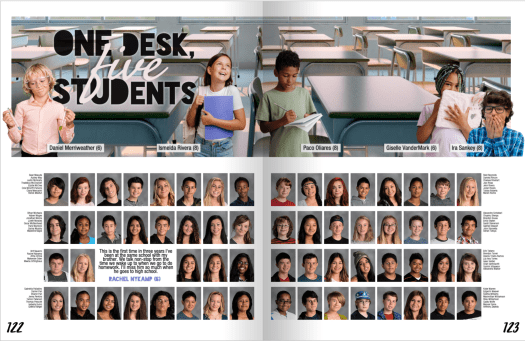
3. Get Personal with Portraits
Personality profiles and student life modules both create opportunities for an inclusive yearbook by targeting lesser known students or students with interests outside school-sponsored arts and athletics. These content modules add voices to the portrait section of your yearbook!

Take advantage of the additional space you'll create by shrinking portraits to pull out more content from your student body.

Fall crowdsourcing ideas for student & classroom photos
Starting and finishing strong isn't just for marathons (although advising yearbook sure feels like one at times). The fall months are ideal for beginning the momentum for your yearbook program. From building your team to selecting a yearbook theme, the fall is an ideal time to begin working alongside your school community. Fall in love with these tips to crowdsource more yearbook photos during September, October, and November.
Fall celebration photos to crowdsource
Use the fun “National Holidays” to create dress up days, activities, or even sidebar coverage for your yearbook. Libraries and DEAR Time can be the focus on September 6, Read a Book Day. Photographs of students with their stuffed friends on September 9’s National Teddy Bear Day make for a cuddly sidebar that pairs well within a classroom PJ Day. And let’s face it, nothing says volunteer and teacher appreciation like National Coffee Day on September 19!
Some other fall holidays to use when sourcing photos include:
- World Smile Day on the first Friday in October
- National Coaches’ Day on October 6
- National Reptile Awareness Day on October 21
- National Sandwich Day on November 3
- National STEAM Day on November 8
- National Education Week during the week before Thanksgiving
STEAM Day on November 8 is an opportunity to show students collaborating and also gather the whole picture (pun intended) of a project from ideation to completion!


Source POV photos
Social media continues to be a steady stream of photographs and posts from the perspectives of parents, staff, and students on your campus. Commenting, “May we use this in the yearbook?” is a way to build excitement for the book and encourage a student whose photo is truly worth sharing beyond their social feed. Some Treering schools promote a hashtag that equates reprinting permission and also makes it easy to search for images.
Using photographs sourced from parents, staff, and students adds a layer of authenticity to your yearbook because it involves new perspectives. Consider crowdsourcing photos from
- Fans at athletic events
- The cast and crew of the musical
- Art students and their in-progress works
- Two students snapping the same event, from different angles
- A period of time, such as the prep hours before the Homecoming dance
As always, a call to contribute to the yearbook is also a call to purchase a yearbook. Use these fall events as opportunities to sell yearbooks as well.
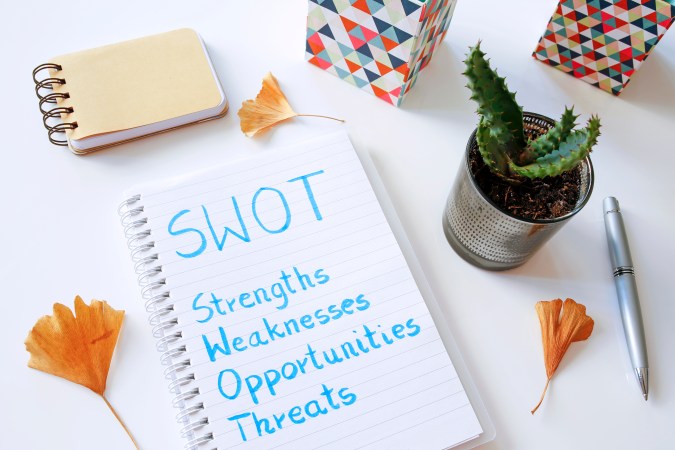

Partner with classroom teachers to source yearbook photos
There are those record-keeping, awareness-raising, champions of academia on campus who photograph student activities. Those are the teachers with whom to connect. (For every teacher-storyteller on your campus, there will be one overwhelmed with the idea of one more thing to do. Know your audience.)
Classroom photos don't always have to be posed group shots of students. Classroom photographs can also include workspace photographs. Flat lays of student and teacher desks or open backpacks offer insight into personality, workstyle patterns, and any quirks. This is also a way to feature those camera-shy campus personalities.
Some teachers choose to incorporate photography in their lessons. You may use the results as a way to showcase student art and cover classroom happenings.

Classroom photo tips
Confession: academics photos used to be my least favorite. There is so much glory in snapping an action shot from a soccer game—those are the photos that bring the likes and shares. Well, what if we approached classroom photos the same way? Using the tips below, your classroom photos can be just as exciting.
Tip #1: Focus on the reaction
Miley was right: it's the climb. When we showcase the day-to-day, it provides meaning. A-ha moments, in-process projects, and brainstorming sessions are just as important as the end results. Have your camera ready for laughter during a monologue or the face of concentration during a science lab.
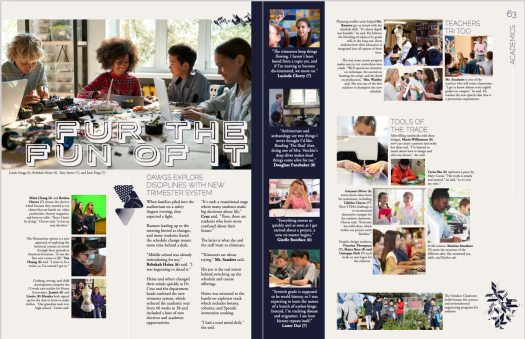
Tip #2: angles aren’t just for geometry
Of the problems with "work" photos is students' faces tend to be pointed at the desk. My yearbook adviser used to say, "Zoom with your feet." Here are some quick ways to do just that.

Use your environment
Desks provide epic leading lines and a captive crowd adds depth and excitement. Above, the combination of depth of field and a crouched position shows the rapport of classroom teachers during an in-service. Use the crowd the next time you are photographing classroom presentations, calendar time, and open house.


Up, up, up, and away
The birds-eye angle (right) shows the same students and adds the intensity of their work by showing copious notes and study materials. The angle works well for groups studying together as well as individual students drawing or reading.
Tip #3: make a list and check it twice
Because you can’t be everywhere, enlisting the help of your teacher comrades is one way to increase both content and coverage. Share this list of ideas with faculty and staff to give them ideas (or else, you’ll be drowning in group shots).

Just like the yearbook represents the entire school community, the academics section highlights the bulk of a student's in-school day. It shows the distinctives of each department. It showcases students’ work. It covers the diverse learners on campus. You can divide coverage by
- Grade
- Subject
- Quarter
Special considerations for including exceptional learners
To paraphrase the Student Press Law Center, yearbooks cannot separate or denote students as members of special education programs because it is a part of their private student record. Always check with your district to see if they have a specific policy.
So, grab your yearbook team and get in the classroom to apply these photo tips. Your academics section will thank you.
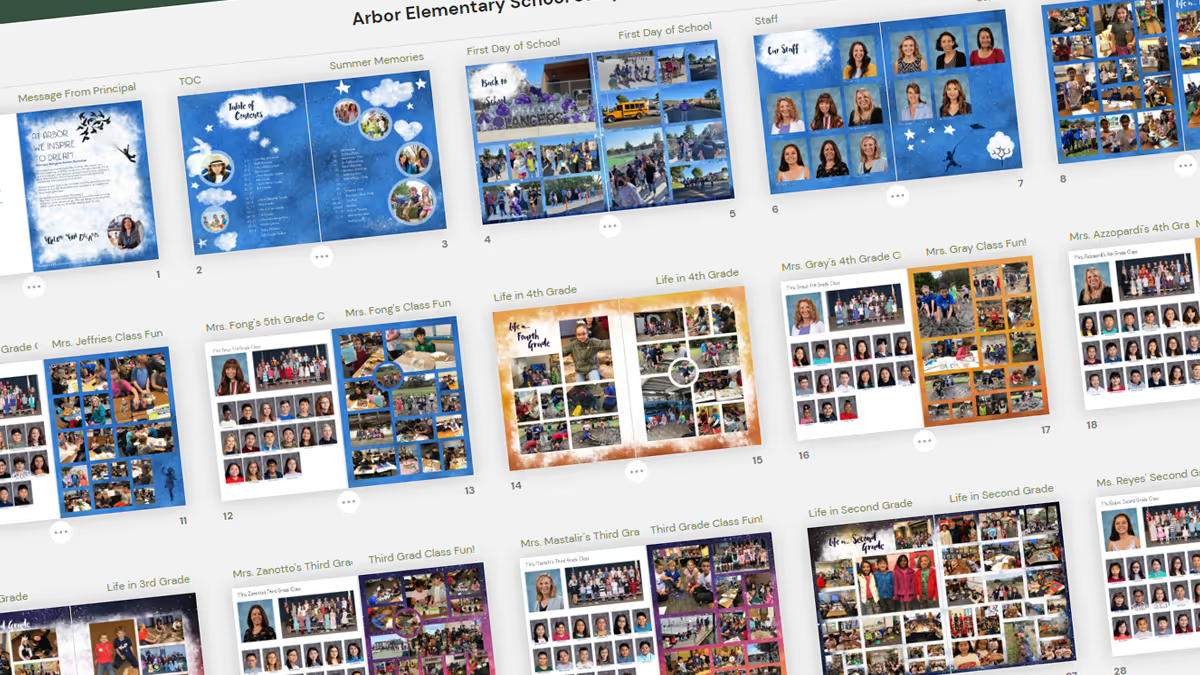
Pages to put in the yearbook
It’s go time: a blank yearbook ladder is in front of you and you need to know which pages to put in the yearbook. Do you take a chronological approach and cover events as they happen? Or should you create a sectional yearbook and handle coverage topically? Did you even know there were options beyond this is what we’ve always done? Below are samples of how other schools have done it and their rationale.
Put your yearbook pages chronologically
Sequoia high school’s yearbook uses 50 of its 148 pages to cover academics, student life, and special events on spreads. The two spreads below show what happened in the month of January and cover the literary food festival, spring musical auditions, lunchtime candids, as well as coursework from economics, Spanish, drafting, logic, yearbook, and graphic design classes. These spreads feature over 40 students and five faculty members.
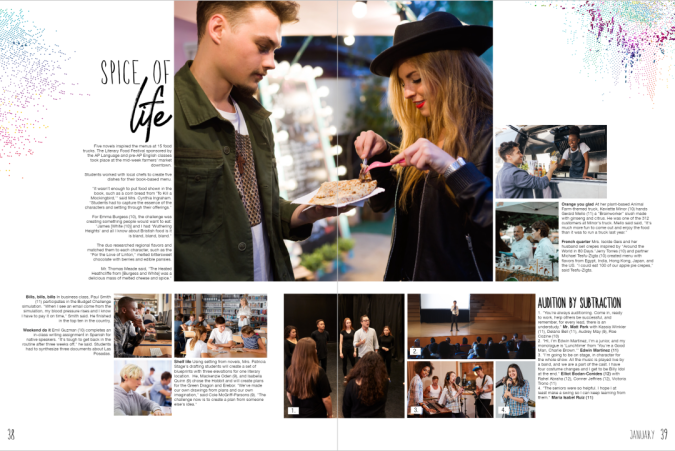
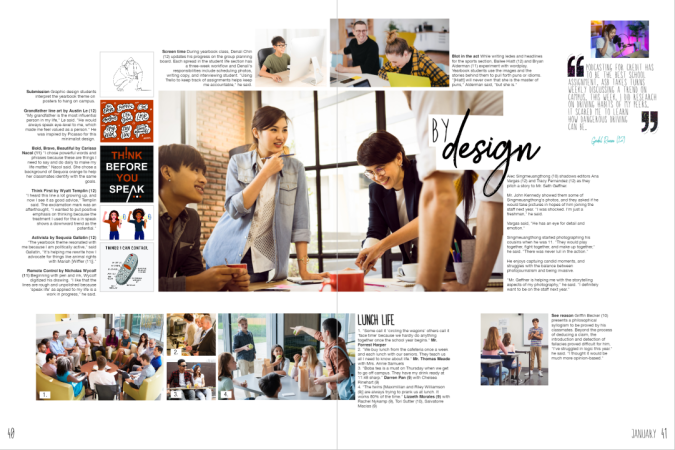
There’s no rule on how to put pages in your yearbook chronologically: we’ve seen schools organize their yearbooks monthly, quarterly, and seasonally. Treering's Seasons of Our Lives yearbook theme makes it easy to put pages chronologically in your yearbook.
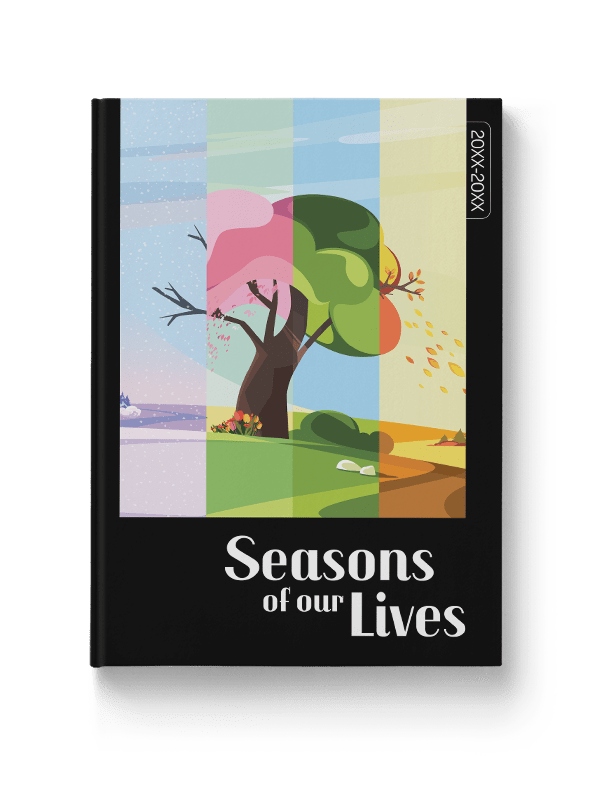
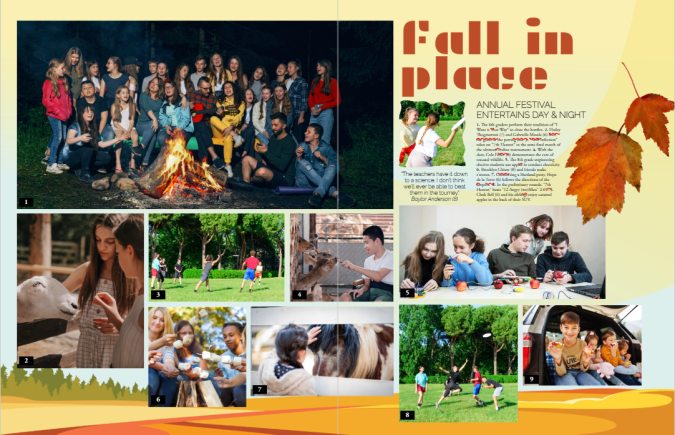
Feeling ambitious? Weekly chronological coverage can be of value to larger or K-12 schools within modules dedicated to academics, club activities and meetings, plus a sporting event of the week.
Chronological cover yearbook coverage helps keep you organized by:
- Structuring your coverage: you can’t cover an event after it’s passed
- Building in mini-deadlines: because you have a structure, you can build due dates and workflows
- Telling the story of the year as it unfolds
Use traditional yearbook sections
Tradition works for a reason. Done right, yearbooks show the complete picture (pun intended) of how students contribute to their communities. It’s a visual reminder of how each story weaves together to become a group narrative. Yearbooks are definitely worth bonding over.
By using sectional, or traditional, coverage to put together your yearbook, pages are placed in topical categories. We know to find Start with Hello in the club section and volleyball in sports.
Traditional sections to put in your yearbook include
People
Student portraits (organized by class, homeroom, or grade), staff, and personality profiles tend to dominate yearbooks. Consider breaking up coverage by adding in siblings, outside-of-school hobbies, and international students.
Student life
All the big, schoolwide moments plus the small distinctive ones (think homecoming, Read Across America, hot cocoa in Mrs. Cruz’s classroom, Dot Day, lawn chair lunches, etc.) make their home in the student life section.
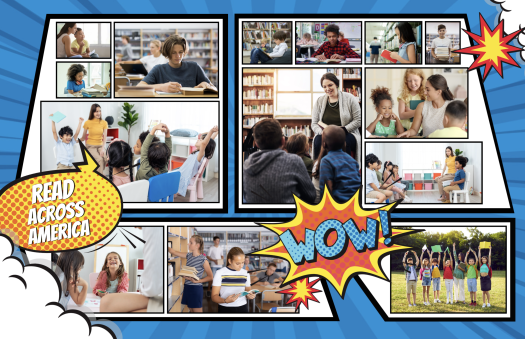
Organizations
Clubs and committees that comprise a large portion of student life may warrant their own section. If most of your clubs are inactive beyond a monthly lunch, consider keeping club activities in the student life portion or feature the group photos in the reference section.
Sports
Remember, action shots have a place, as do club sports, pre-game rituals, and scoreboards.
Academics
If you’re not putting a “Life in…” page, consider grouping academics coverage by grade or subject. Ensure daily classroom activities, as well as holiday parties, are included in the coverage.
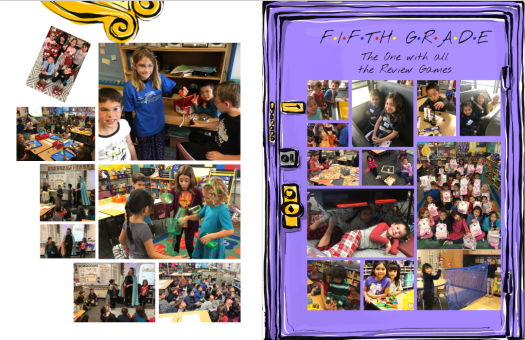
Reference
Put pages devoted to the index, group photos (club and team), and ads in the reference section of the yearbook.
If you need additional inspiration for which pages to put in your yearbook, check out these sample ladders from other schools and adapt them to fit yours.
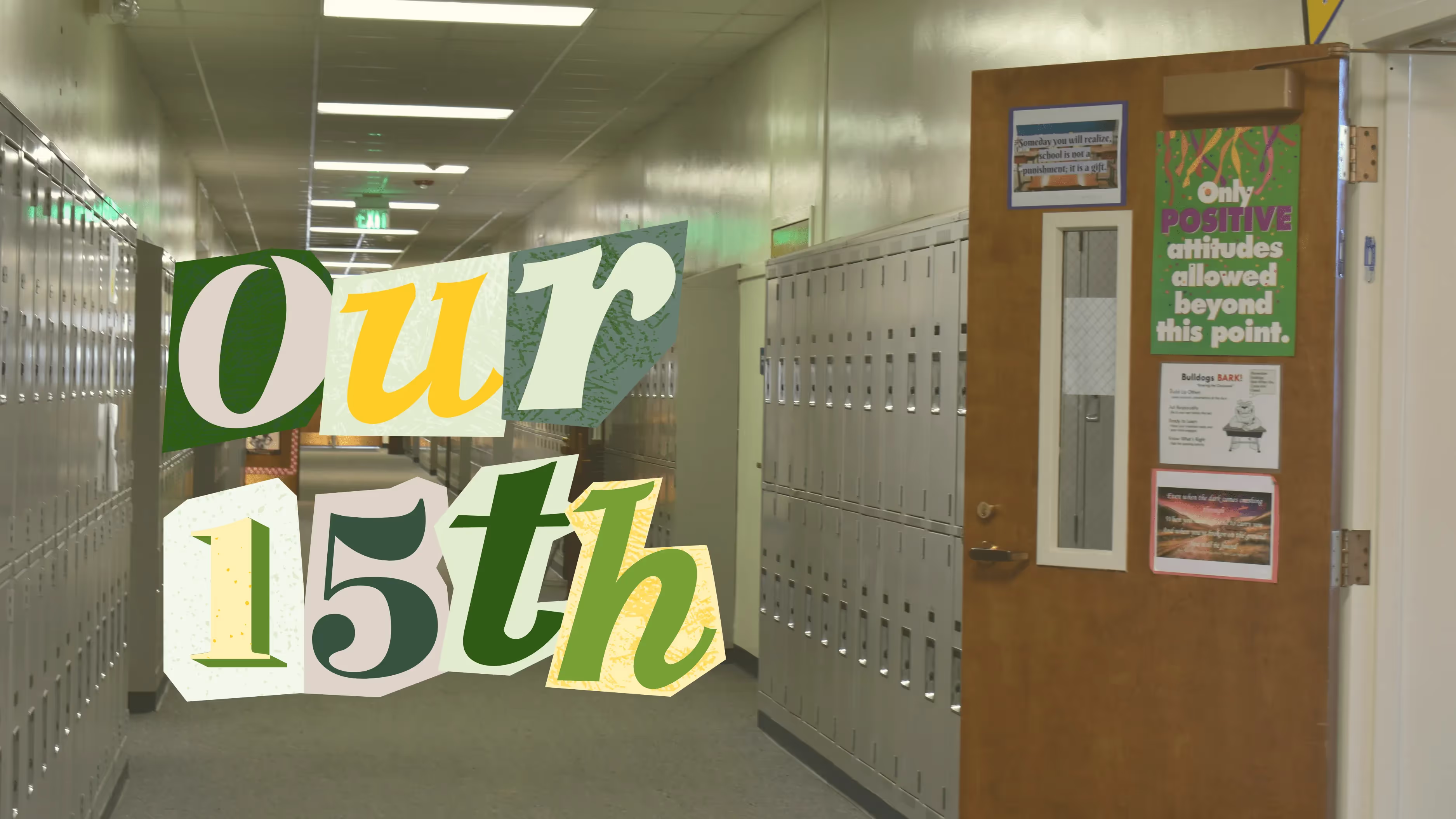
3 questions about school anniversary yearbooks
How to capture a milestone year in your campus’ history frequently pops up in adviser chats. Yearbook Hero Beth Stacy said her team “linked the past to the present” with their 75th anniversary yearbook. That’s the goal.
1. What’s the Best Way to Show School History in an Anniversary Book?
Anniversary books don’t have to deviate from your normal yearbooking protocol. It can be minimal, such as in a 40th anniversary book, asking students where they want to be in the next 40 years. Or devoting a spread to a list of 100 things to love about your school in its 100th year (remember to include alumni). Or even showing photos of teachers on the staff page from the year the school was founded.
The ideas below take up a spread or two, so your focus can be the history currently written in the year at hand.
School Timeline
Schools commonly create a timeline outlining specific milestones and achievements. For Rock Academy in CA’s 15th anniversary, yearbook creators featured two pages of school history with old photos of current students.
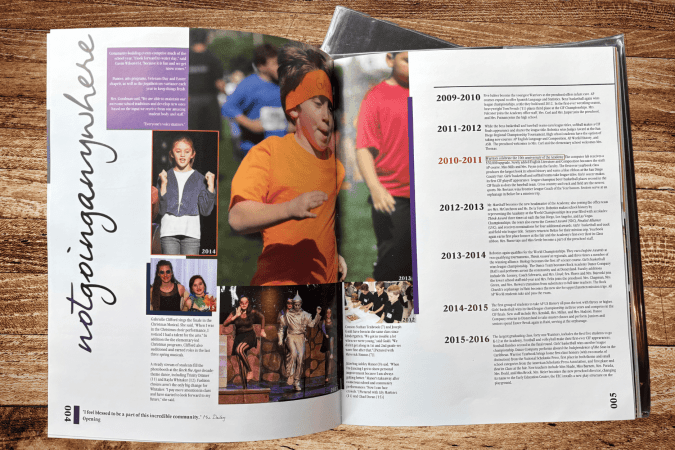
The timeline included when faculty members joined, the expansion of course offerings, and photos of the first-ever graduate. Old photos had the year on the bottom right corner to denote the past from the present. They continued this trend on divider pages.
Cover the Years
When Wayne High School in OH published its 75th yearbook, the editorial team created two spreads showing the school's history through their yearbook covers. The team at Wayne worked with the alumni association, the local historical society, and the school archives to find most of the yearbooks.
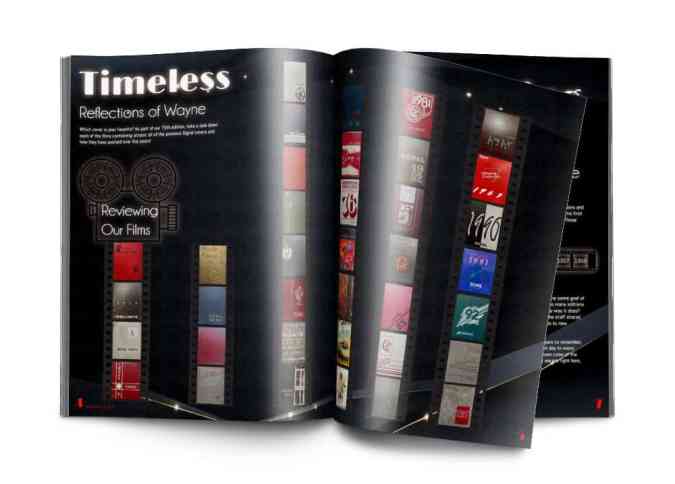
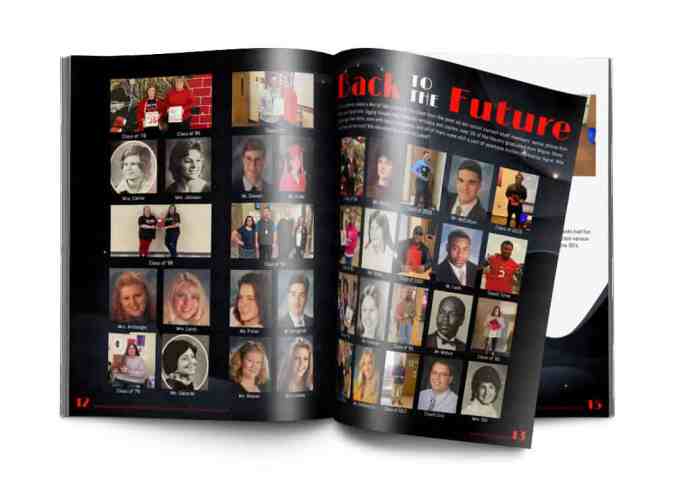
Then and Now
(Side note: this would make a great anniversary yearbook theme.)
The team at H.O.P.E. in TX also took a trip to the yearbook archives. They scanned old photos from previous books to do side-by-sides with their present counterparts. They also researched the cost of goods from 30 years ago to show life off campus.
Adviser Rita Johson's team also interviewed alumni from the first graduating class and pictured previous advisers in the colophon. She said this was the first year they created a style guide; the yearbook design process evolved from more of a scrapbook to using mods. The team enjoyed exploring the school archives and found 19 yearbooks for the school's 30 years.
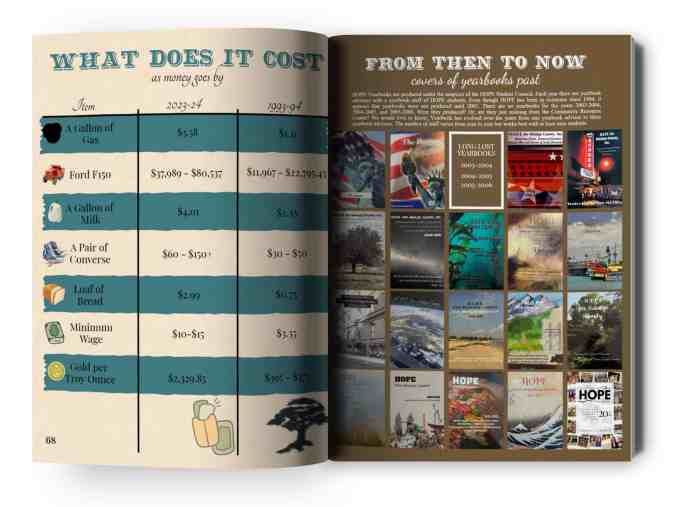

Pro tip: Save yourself the scanning. If you’ve been with Treering for multiple years, your yearbook covers and photos are in your yearbook account.
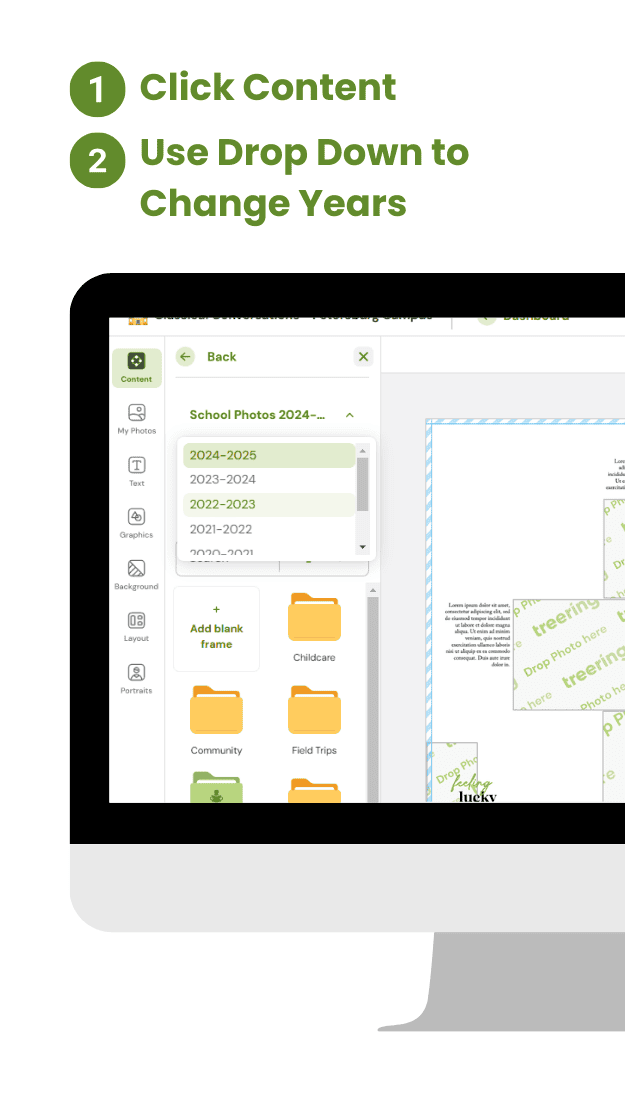
2. What’s a “Good” Theme?
Well-executed themes cover the school year both verbally and visually. It shows and tells. In a milestone year, like your school’s 50th anniversary, it may be tempting to try and carry this concept through the entire book. Full stop. Unless the winning point guard from the 6th grade basketball team is currently coaching his great-grandson, resist the urge to make your anniversary the yearbook theme. This year (the buyers!) will always be the primary focus.
Verbal Theme Ideas
Because yearbook creators love the look, we’re starting with the “sound” of the theme. Headlines, theme copy, and spin-offs should reflect your yearbook’s theme.
Evergreen Anniversary Theme Ideas
- Construction-focused: “Built to Last” or “Foundation for Tomorrow”
- Timeline focused: “Our Journey Here,” “Milestones Marked,” and “Then and Now”
- Younger school: “The Wonder Years”
- Older school: “Timeless”
Year-Specific Theme Ideas
- 10-20-30, etc.: “Decades of Excellence”
- 15: “Time to Shine”
- 50: “Golden Moments”
- 100: “A Century Strong”
Visual Theme Considerations
Align your theme’s aesthetic with the verbal tone. Taking a page from my junior year, the theme “Reflections” should have some mirroring in the graphics, if not some shine on the cover.
Traditional anniversary gifts—a list that dates back to the 19th century—prescribe the following:
- 10th anniversary - tin or aluminum
- 15th anniversary - crystal
- 25th anniversary - silver
- 50th anniversary - gold
You can easily add such elements to your cover finish. Bringing your “golden anniversary” to life can be as simple as adding gold foil. Treering also offers silver foil and clear UV embossing.
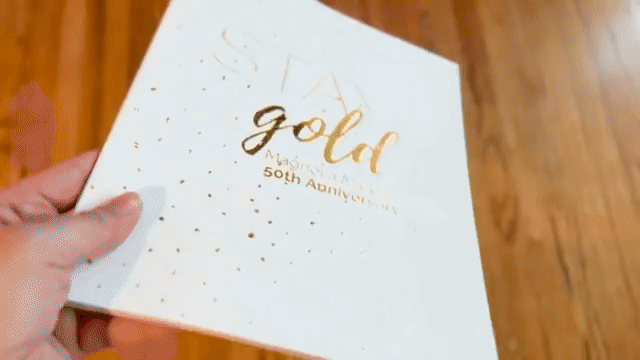
Inside your yearbook, you could (choose one!)
- Denote old photos by making them black and white or using a Polaroid-style frame (like HOPE did)
- Hide 20 pictures of your mascot (if it’s your 20th)
- Use blueprints or construction photos for a significant building project
3. When Should I Do an Anniversary Yearbook?
We see anniversary books for 10-100 years, and everything in between. The caveat here is that if your school is doing nothing, why would the yearbook? Align with your school community to get the final answer on this one.
Getting Personal: Treering’s 15th Anniversary Book
As Treering’s 15th year closes, we created our first-ever anniversary yearbook. Our staff took yearbook photos on the conventional blue background. As a cross-functional team, yearbook creators interviewed staff members and collected photos of people in the home office as well as remote teammates’ home offices.
Unlike a school where students promote and graduate, many staff members are in their second decade with the company, and two of the founders are involved in the day-to-day. The history section features photos of the early offices and staff, the original 44 schools, and a history of Treering-produced theme art. It is heavy on nostalgia.
We look forward to celebrating many more milestones with you.
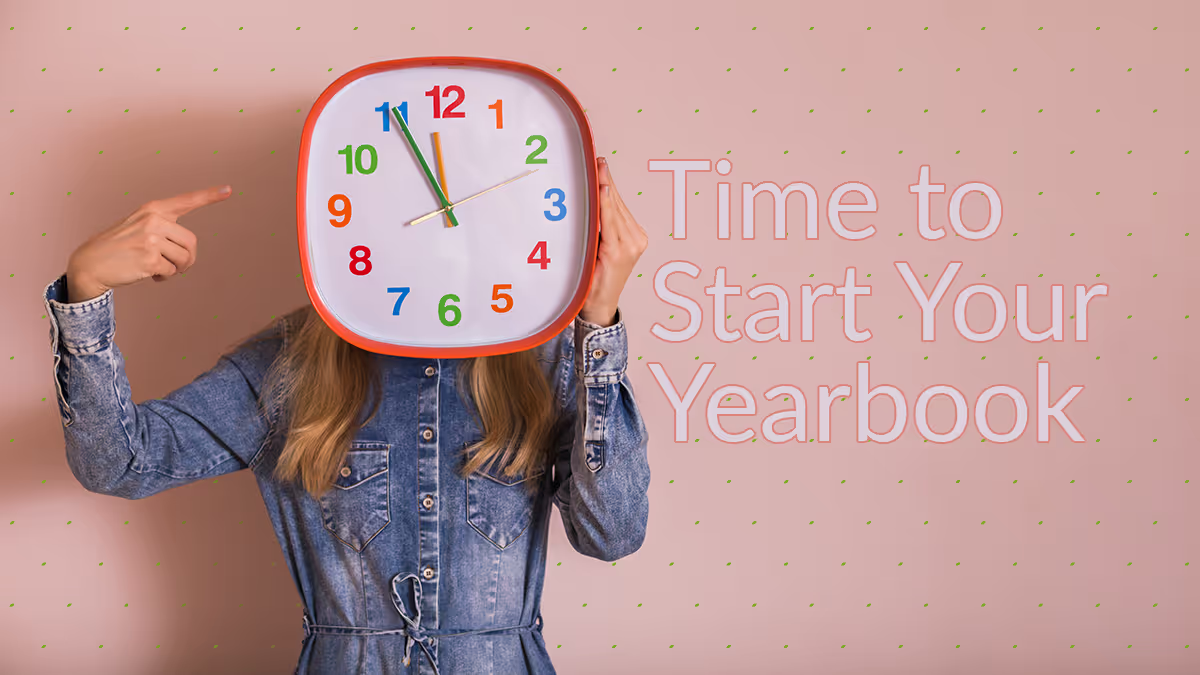
Create a quick, easy, and beautiful elementary school yearbook
With most of the school year in the proverbial book, we are counting down until summer vacation. End-of-the-year celebrations aren't complete without a yearbook. If you're the one wearing the yearbook coordinator crown, it's time to circle the wagons and quickly create your elementary school yearbook without sacrificing style. We have live webinars on Wednesdays to help jumpstart your second semester.
Step 1: upload your student roster
Your first step is a quick visit to the front office (remember to bring some lattes) to get a community and student roster. This seems tedious. It will save you hours if you do this first. You will easily be able to
- Tag to ensure inclusivity or to create an index
- Start marketing and selling your book
- Receive your yearbooks sorted by your choice of grade, teacher, or last name which will save you tons of time once they arrive
(We promise, you'll thank us later.)
Step 2: get the word out
With an updated student roster, you can now effectively communicate with your community and launch marketing campaigns that support yearbook building and orders. Examples of communication that will help you build a better book include emails asking for photos, how to purchase books, and special features like creating personalized pages and showing your students/parents how to create e-signatures.
If you really want to ramp up sales and raise awareness of your yearbook project and photo needs, use this month of Instagram, Facebook, TikTok, and Twitter content. There's also a full marketing module in our free yearbook curriculum.
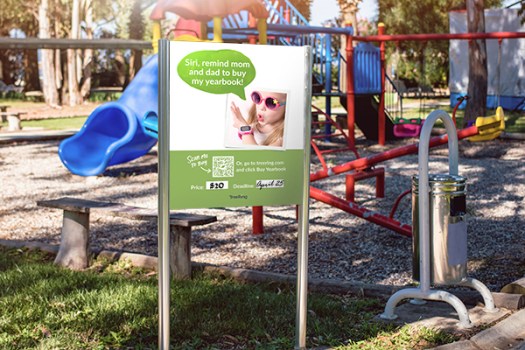
Step 3: collaborate with your community
Following strong communication, you are set up to collaborate on the yearbook with ease. Crowdsource photos from school staff, other parents, coaches, and students.
When possible, assign class pages to others. No yearbook coordinator is an island (or something like that). By building a team, you'll capture more, include more, and stress out less!
Step 4: upload your students' portraits
Whether your elementary school was able to take professional portraits, or you are sourcing portraits from parents, upload these to your yearbook next. Your yearbook provider should have a solution for adding these to your book. You can even use these yearbook spreads to add more content.
Step 5: build your book
Now that you’ve connected with your community and begun sourcing ideas and visuals for your yearbook, you’re ready to select and set up your book themes and styles. In addition to designing your own themes, Treering offers a free library of professionally designed themes. Each theme package includes layouts, font pairings, and graphics to tie your look together. You can also 100% customize your own.
Set spreads aside for
- School events such as fun runs and book fairs
- Sports (If your school doesn't have teams, crowdsource photos of students on their outside sports team)
- Holidays
- Trends
- Clubs
- Class favorites
Build a beautiful yearbook with features like auto-page layouts that magically lay your photos out beautifully on a spread or pre-designed pages that cover the Best of the Year and Year in Review plus student-generated content through fill-ins for a quick elementary school layout.

Step 6: set your yearbook to print ready!
Drop the yearbook and walk away. In all seriousness, hit “print-ready” to send your files to the printers and, if you're using Treering, you'll quickly have your books in hand in three weeks or less! If for any reason you want a little more time, it’s easy to adjust print-ready deadlines too. As the yearbook coordinator, you're in charge!
Step 7: distribute the yearbook and celebrate!
All this work is worth celebrating! Work with your parent group to host a yearbook signing party. It doesn't need to be fancy or cost you additional money; this could be something special like
- Playing music at lunch
- Offering a jeans day to yearbook buyers if you're a uniform school
- Allowing yearbook purchasers to bring a stuffed animal to school
- Setting up signing tables at a year-end school event
QR Code is a registered trademark of DENSO WAVE INCORPORATED.

The one layout template you need
Yearbook coverage ideas might be our favorite topic: brainstorming ways to represent more students, resulting in a more authentic narrative of the school year. It could also mean more photos, interviews, and work for you. After a colleague shared Kingsbury Country Day School’s yearbook, a lightbulb went off. Yearbook coordinator Kara-Jane LaVoisne created the perfect layout that includes over 60 students, highlighting their impact and participation in school events.
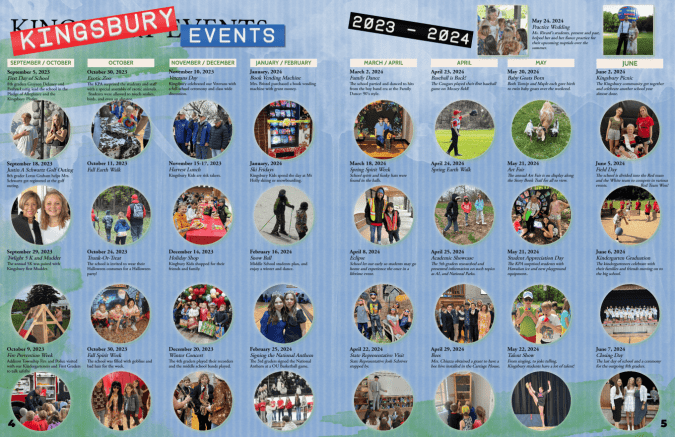
Why We Love This Template
This spread packs a punch because it covers a large span of time in little space. It covers 24% of the school across two pages. It showcases events that would not be covered elsewhere. This template is also well-designed: it’s clean and has multiple reader entry points.
Home For Smaller Events
Oftentimes, we have several photos that don’t fit on a larger spread. This is especially common in books that do not take advantage of modular design. LaVoisne took advantage of those moments to create a means to include them.
Versatility
While LaVoisne used this template for a school-specific year-in-review, you can use it once per section or season. For example:
- Fall, winter, and spring PTA or ASB events
- An overview of the sports seasons
- Semester rundown of student life
If you’re feeling ambitious and have the content, an hour-by-hour review of a major school event such as the talent show or homecoming weekend could be a showstopper spread for your yearbook.

What’s most important: your yearbook team celebrates the people in your campus community. This layout is just one way to cover more students in your yearbook. For more creative yearbook coverage inspiration, check out:
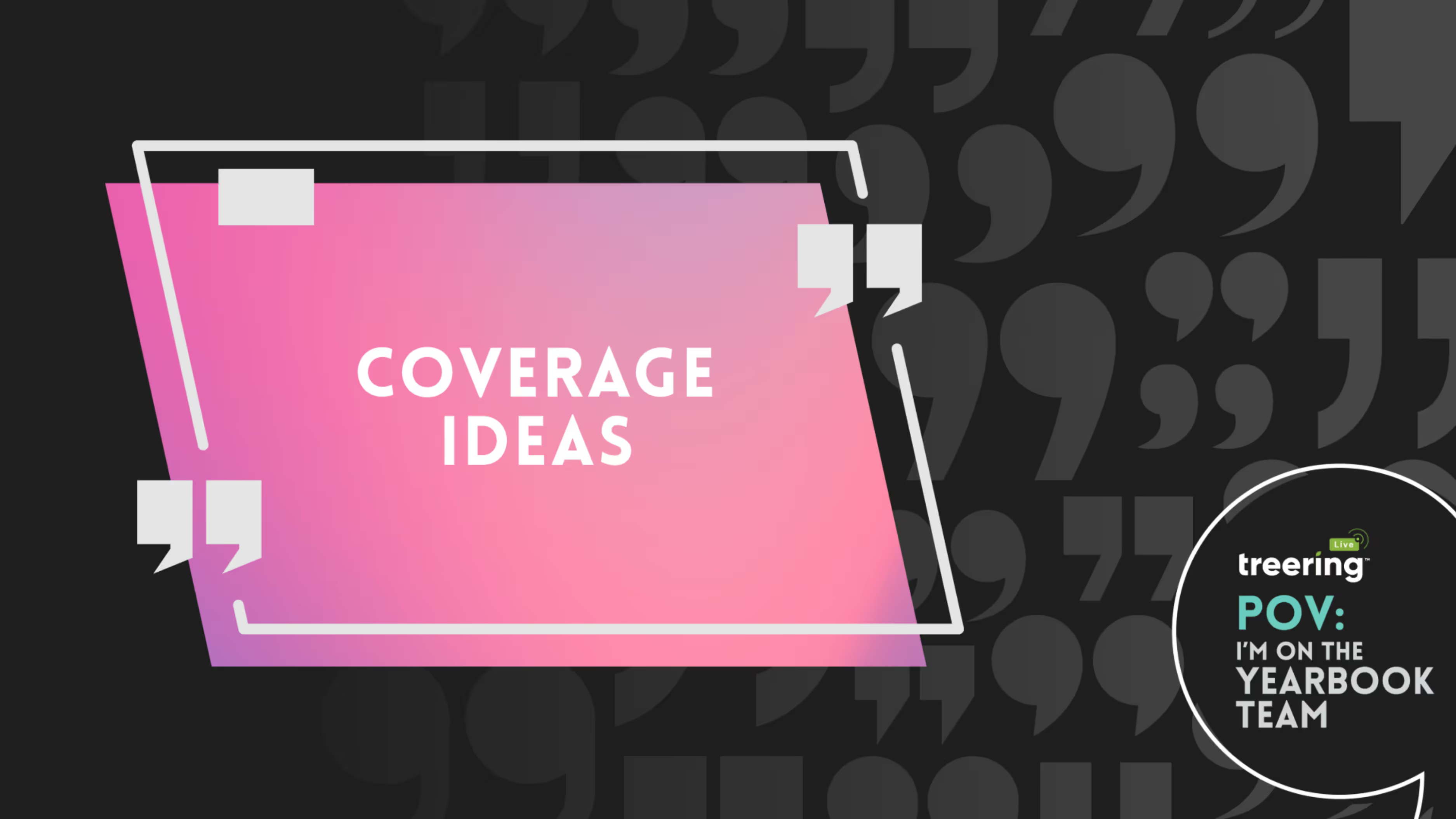
Coverage ideas: how to get more students in the yearbook
Thinking critically about yearbook coverage is an editorial mind shift. Shiny things such as theme art and backgrounds often take precedence. Yearbook coverage highlights all the memorable people and events. And there is a flip side: planning yearbook coverage is also a conscious decision on what you’re not going to cover.
Coverage Limitations
Yearbook price, page count, and–gasp–traditions limit coverage. For Treering schools, page count directly influences the price point. Your per-book price is based on the core page count (does not include custom pages), and cover finish.
Page Count and Coverage Budgets
For those with a class or club, a coverage budget helps you and your team be intentional. Start by listing the sections in your book. Then budget spreads to each section.

Yearbook Traditions
We don’t mean the fun ones like Yerdsgiving or distribution. No matter the school size, there is an element of expectation on you as the adviser. Be aware of the sacred cows of your yearbook program. These can range from color palettes to the ultimate sacred cow, senior quotes. (We interrupt this blog to give you the resource you didn’t know you needed: three reasons to get rid of senior quotes and how to replace them.)
If you're willing to take the energy to fight tradition, and have a clear reason, go for it.
For example, when my school hit 11 years, my students deviated from alternating purple and black covers. They created a blue and red book, with PK-6 on one side and 7-12 on the other. Their reasoning? For the first time in school history, there were separate principals for the upper and lower schools.
My students wanted to highlight how each grew independent of the other, and instead of pushing to do two smaller books, recognized the power of us all still being in one building. The yearbook students saw it as a picture of unity; the other students saw it as the school spirit equivalent of treason. Bottom line: blue and red make purple. Once that line made it around campus, everyone loved the book. Ten years later, we have not published a purple or black book.
Change takes time.
People Over Events
This is our coverage mantra. When you highlight people, your yearbook develops an emotional connection as students see their art, stories, meaningful quotes, and photos of their experiences. Every student wants to know they were in it. They were included. Their story was deemed valuable enough to be in the yearbook.
We're always going to highlight people over the events. People happen in the context of the events, and in each event, highlight those behind the scenes, up front, and watching. Remember:
- Set up and take down
- Fan and audience reactions
- Snack bars, spirit shops, and the bench
- The booth: announcers, tech crew, coaches, press
You need not think each will get a spread. Modular design is a way to fit more content in and do it stylishly. (If you don’t want to start from scratch, Treering themes “POV,” “Tied Together,” and “Crafted” have modular layouts from which you can model.)
People First Ideas
We want to move away from students opening the book, finding their name or face, and moving on. Below are some ideas to help you add stories and make them dynamic so people pause their perusal to get personal.
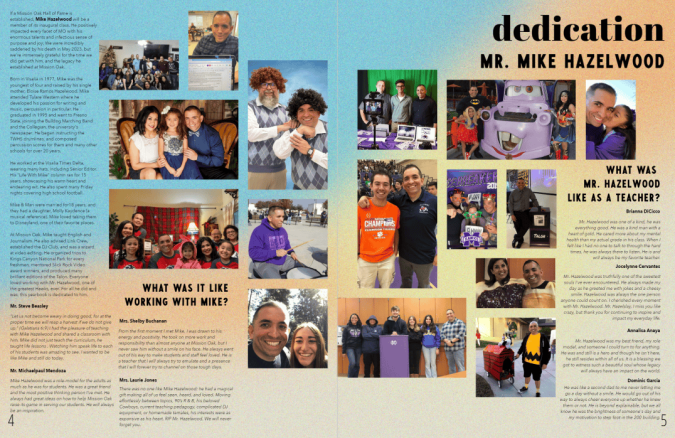
Dedications, Retirements, and Unsung Heroes: Every school has one teacher, volunteer, or student leader who positively impacts school culture. Honor their impact with a small write up or a full-spread dedication.
Future Plans: Publish elementary school “What I want to be…” and high school post-graduation plans.
Trends: Waterbottles, fashion, and laptop stickers are great. The stories behind them are better.
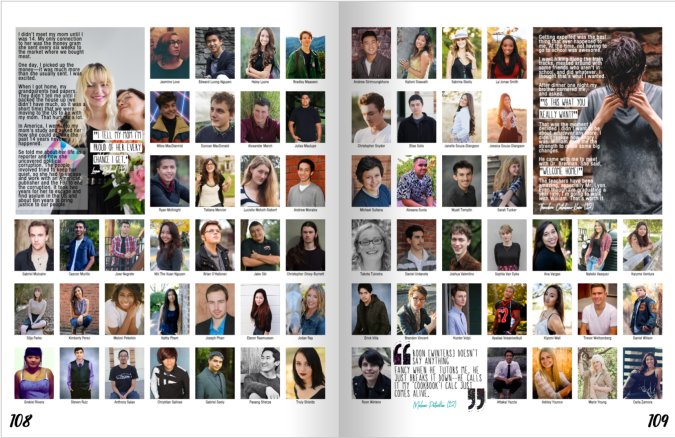
Personality Profiles: We love making room for additional stories by shrinking portraits and adding content.
Pets: Pets are an easy way to cover camera-shy students or get families started with crowdsourcing.

School Map: Students spend 8-12 hours on campus. Find out where the best study and nap locations are. Interview athletes from each sport who practice on the turf.
Interactive Pages: One thing we saw multiple times during the duration of TRL 24 was “Guess Who?” spreads and modules:
- Guess Whose… eyeglasses, water bottle, ect.
- Match the baby photo to the 5th grader or teacher
- Match the teachers to their first job
People also loved the Treering About Me pages.
Yearbook Blacklists and BOLO Boards
Many students are easy to cover three times because they fell into the 1-2-3 coverage pattern:
- Portrait
- Extracurricular
- Academics
For those who do not, use the coverage ideas above to get them in the book.
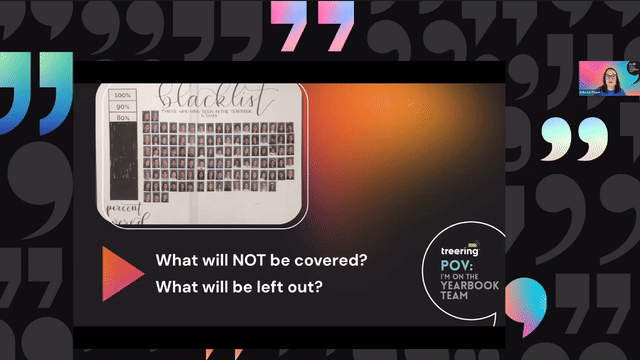
We understand that the same events occur year after year. Challenge yourself to cover them in two new ways. How will you and your yearbook team give a fresh take on the students on your campus this year?
This blog is adapted from Brent Mikolaycik and Erika Lin Payne’s Coverage Ideas session from TRL 24 POV: I’m on the Yearbook Team. Mikolaycik and Payne came to Treering Yearbooks after nearly two decades as classroom teachers and high school yearbook advisers.
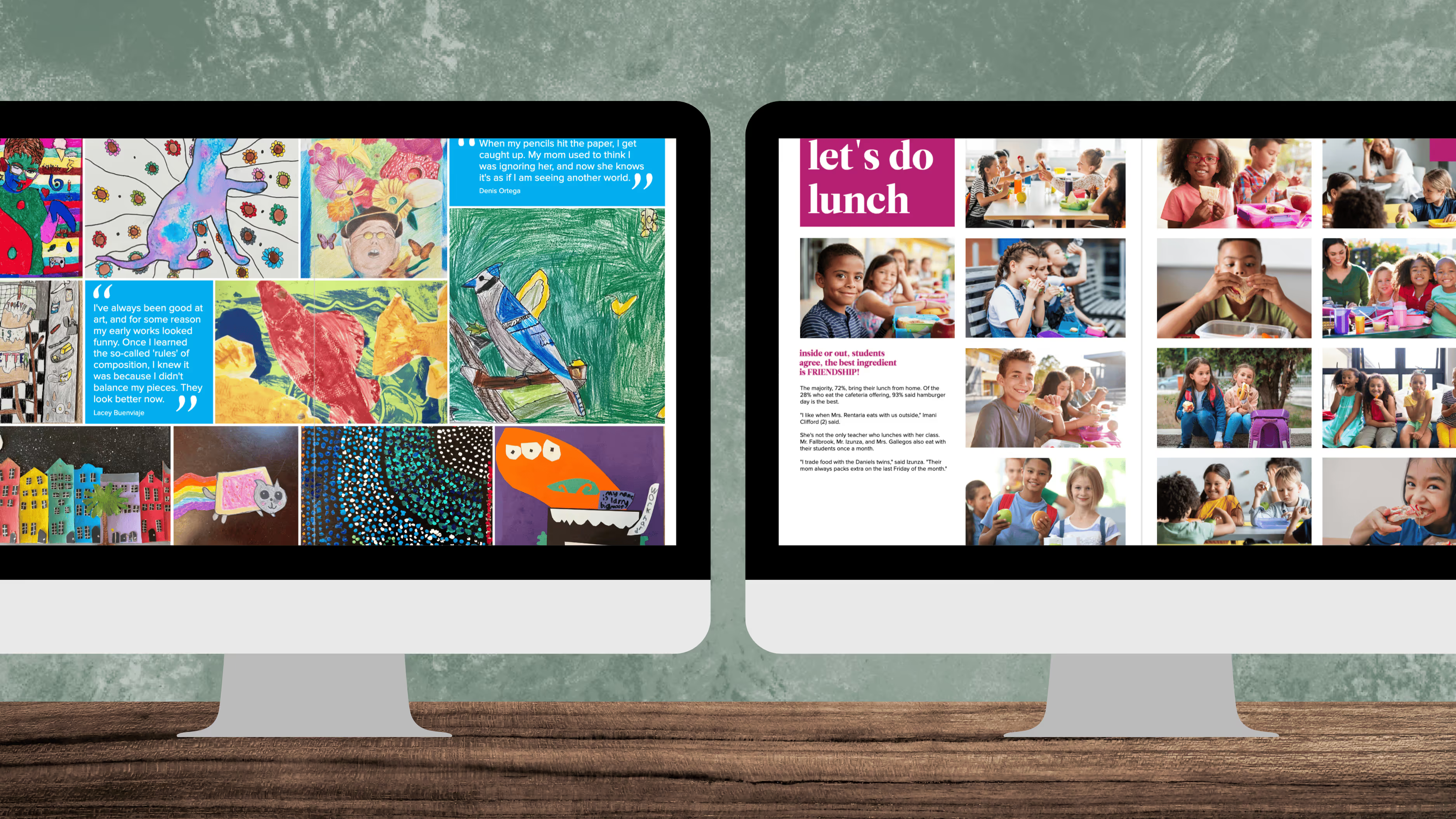
Collage page ideas
Photo collages get a bad rap. Poorly designed spreads without uniform spacing or an overarching theme are little more than a photo dump. (I actually think that’s how my MIL would describe what I do as a yearbook mom. “She just puts pictures on pages.”) Executed well, they become standout spreads.
How Many Photos Should I Put in a Collage?
Answering a question with a question: is it even a collage if it has fewer than 15 photos? Too few can make the page look sparse, while too many can make it cluttered and overwhelming.
A good range for a collage spread is roughly 20-30 photos. While you can find layouts with up to 65 photo boxes among Treering’s 1000s of pre-designed templates, more photos mean smaller photos. Smaller photos make it difficult to discern who is in the picture.
That’s the point of a collage: to increase coverage of events and individuals.
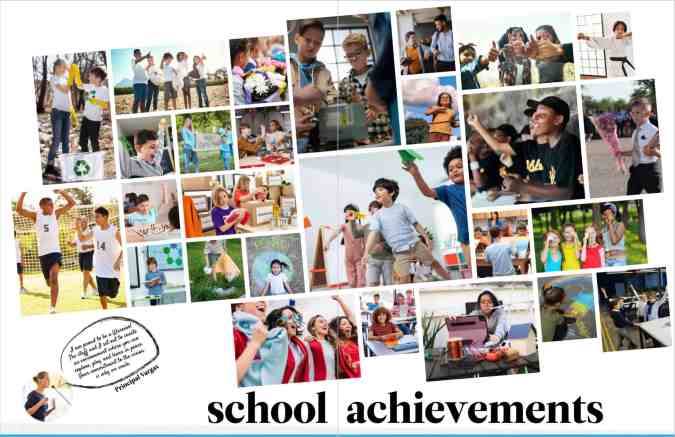
Two Must-Have Collage Pages
When our team looks at yearbooks, the standout books have collage pages for each class or grade and the major school events. While collage pages are a great way to include many photos, too many can become monotonous. Aim to limit collage pages to around 10-15% of the total page count of the yearbook. This keeps the content varied and engaging.
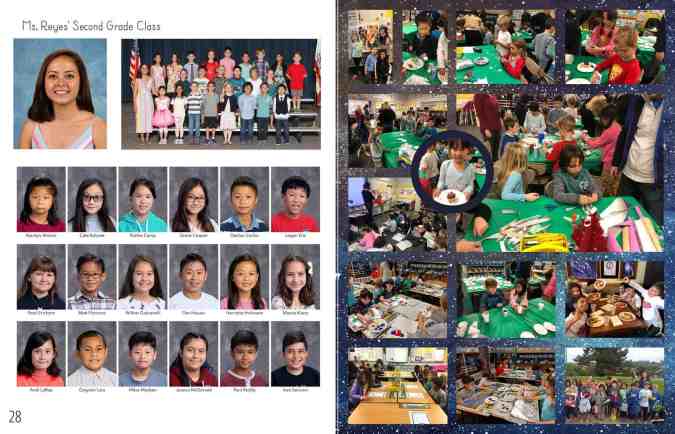
Class Collages
Pairing class photos with a collage of candids gives each class a spread of their own. It shows how each class is different. This is also an easy way to ensure each student is in the book more than once: their “official” photo and a fun photo.

School Event Pages
A collage page makes it easy to cover all-school events such as the jogathon or an awards ceremony, where you end up with 100s of photographs. Other ideas include
- Fan sections at home games
- Movie night
- Father-daughter dance
- Homecoming and spirit week
- Game faces for student-athletes
- Vacations (summer, ski week, etc.)
- Field day
- Spring musical (include rehearsal photos!)
Should I Include Captions on a Collage Page?
Captions provide context for the photo. At a minimum, you should include ident captions. Below or beside the photos, add the students’ names and grades [e.g. Soren Ham (1) and Evangeline Romero (1)].

Middle and high school staffs should aim to add body copy in the form of a story to unite the spread.
Including collage pages in your yearbook is a popular way to add more photos and showcase the story of your school year.

Yearbook in 60 days - part 3: yearbook design
Two blogs ago, we began our journey to start and finish a yearbook in 60 days. From establishing a ladder and crowdsourcing structure to flowing portraits and adding in fall events, the first month yielded a near-complete yearbook. These next fifteen days of our adventure include proofing, promoting, and packing in spring events. All the resources you need are linked below (for help center articles, you will need to log in to the editor help center).
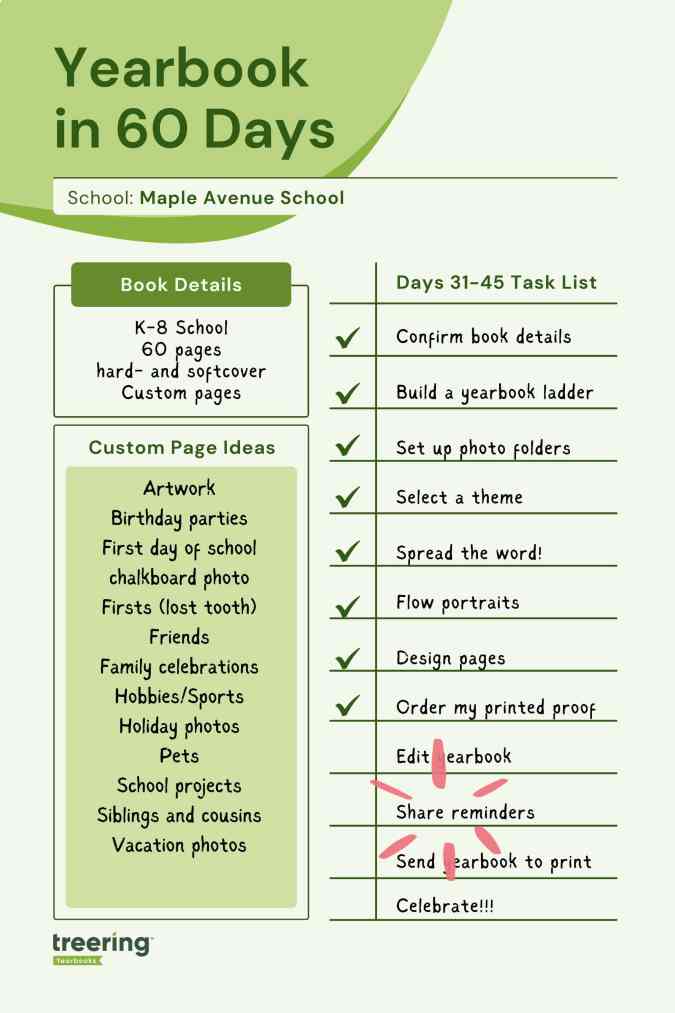
Yearbook (yes, it is a verb) along with us on Facebook, Instagram, and TikTok.
1. PDF Proofing
Just because we are speeding through the yearbook creation process doesn’t mean we will be careless. Proofing tools such as downloadable PDFs and a free, physical cover-to-cover proof of your yearbook are free through Treering.
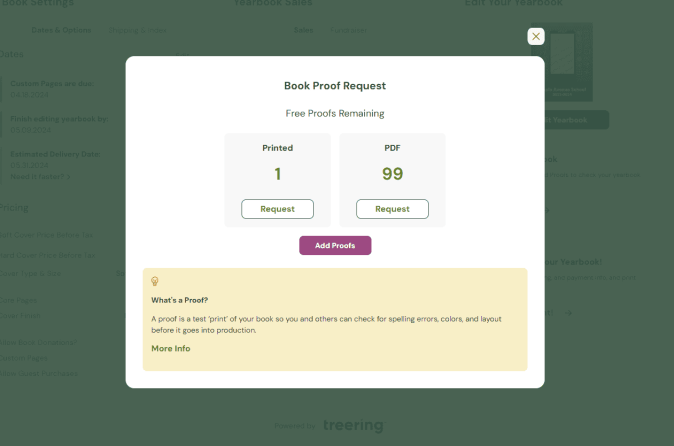
Let’s start with PDFs. English teachers everywhere will tell you errors that are missed on the screen often pop on paper. Read any copy (stories and captions) aloud to assess for tone and errors that digital proofing tools missed. These are low-resolution (the actual print file size might crash your computer), so you can download them quickly.
Use your PDF proofs to also
- Triple-check your portrait pages: correct spelling of names, the accurate placement of students and teachers in classes or grades
- Ensure faces aren’t lost on the edges (margins) or in the middle (gutter) of your spread
- Students are visible in the photos: sometimes, a photo box is the wrong size, and the faces are either huge or unrecognizably small. When possible, try to make all faces on a collage spread the same size.
- Show sneak peeks to your buyers - when parents see their child is in the book, they will buy the book!
Pro tip: use as many of your 99 PDF proofs as possible!
Yearbook Editing Resources
2. Design Pages (Spring/Second Semester Events)
Last time, you learned two ways to design. Because the second semester is unfolding as you build your yearbook, it may be easier to collect photos. This is the time to evaluate those first semester spreads: if they are not full by now, combine events and re-allocate space.
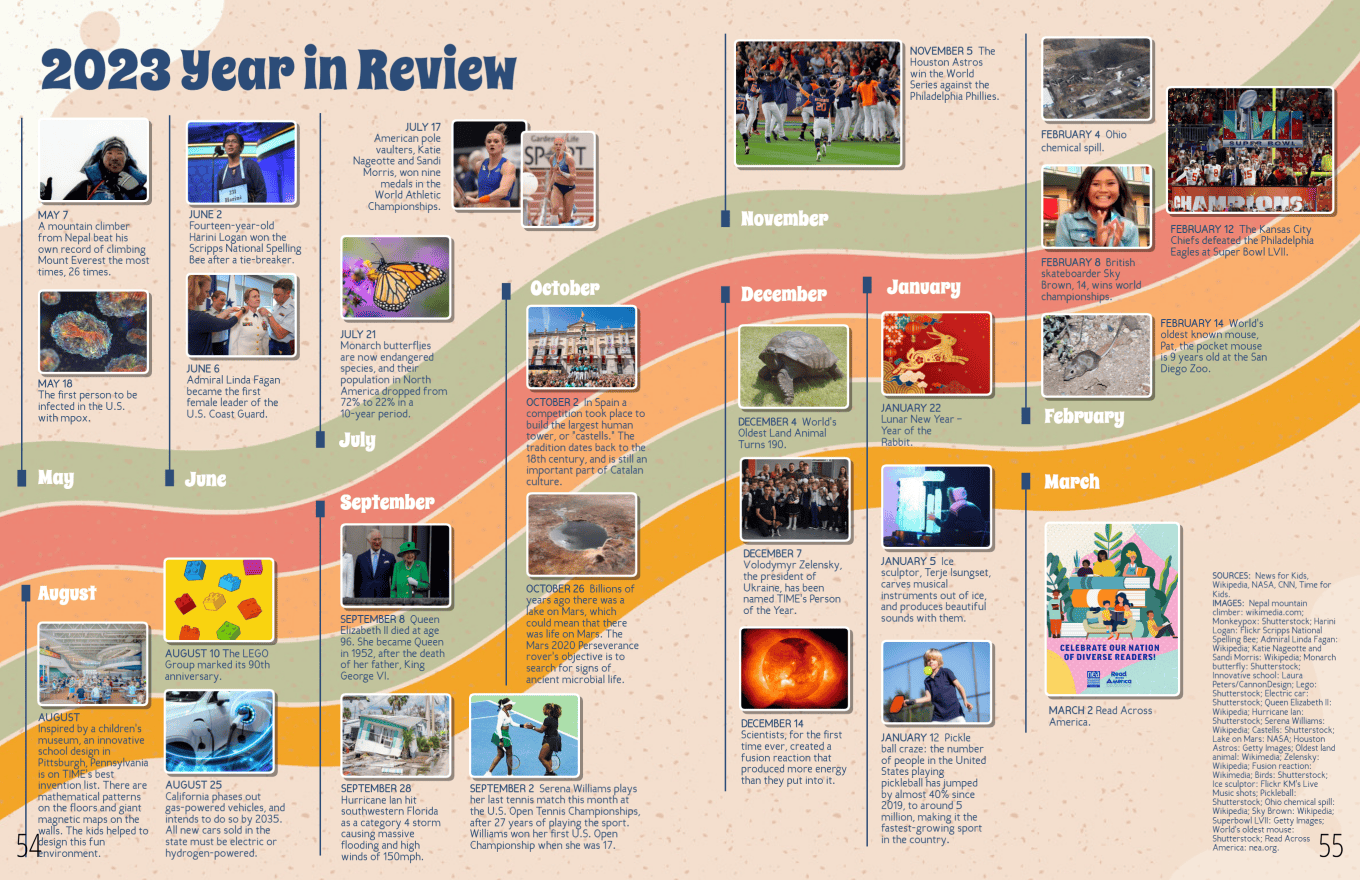
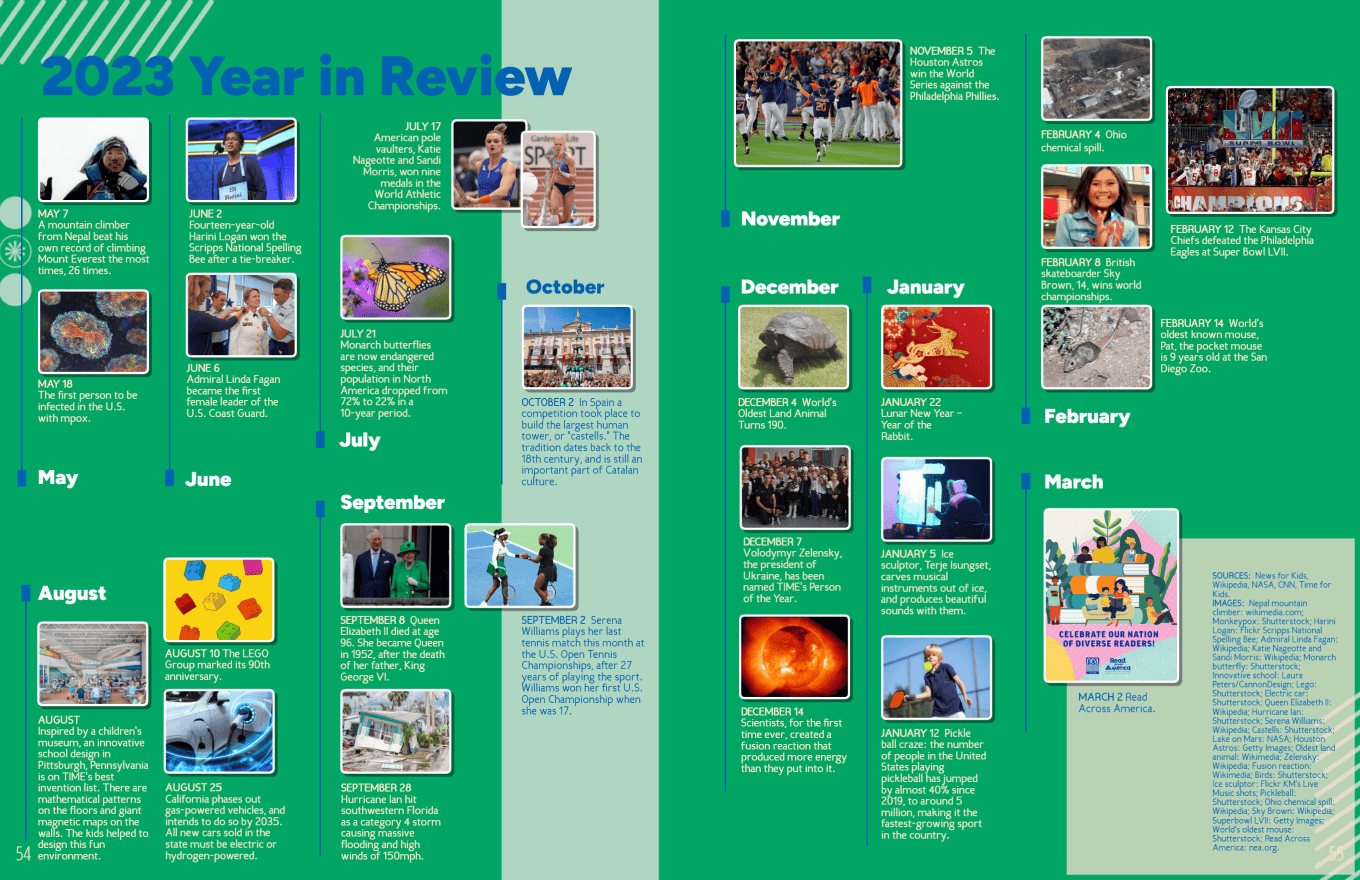
Coverage Resources
- Blog: Six Ideas to Fill Pages in Your Yearbook
- Article: Adding Pre-Designed Pages (You must login to the editor Help Center to view)
3. Purchase Reminders
In these remaining 30 days, up your promotion game by doing at least one thing a week to share about the yearbook:
- Reach out after each school event with the appropriate photo share link and email
- Call or email parents of students who are in the book three times and have not purchased
- Have a contest: the grade or homeroom with the largest percentage of purchases earns extended recess
- Remind purchasers to customize their yearbooks (more on this next time)
- Ask campus influencers (ASB, PTA/PTO accounts, athletics) to hype the yearbook
- Have flyers at a school-wide event, such as the band showcase
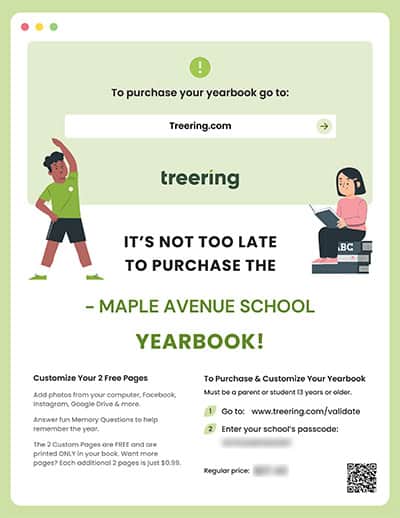
Yearbook Sales Resources
- Google Slides: Customizable Flyers
- Article: Tools for Promoting Your Yearbook
- Blog: 5 Social Media Posts to Sell Yearbooks
4. Printed Proof
Treering’s Marketing Manager Megan P. likes to say, “Works in progress welcome!” Because you need your printed proof in hand before your final deadline, order it now. It can take up to 18 business days for this yearbook freebie to arrive.
With portraits and fall events in the book, there is plenty to evaluate. Use your remaining PDFs for copy and photo edits.
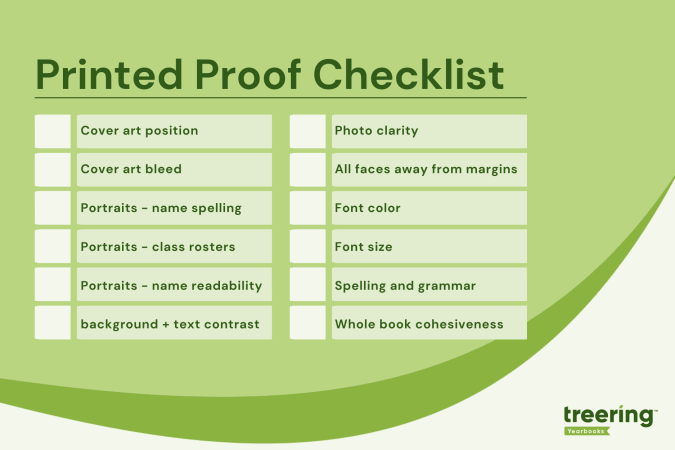
Pro tip: When my printed proof arrives, I take a Sharpie and mark it up. Then, I use it as a tool to clean up each spread one by one.
Proofing Resources
Yearbook with a Friend
Involve a second or third set of eyes during the proofing process. Potential yearbook proofing heroes include:
- Front office staff (they know all the things)
- Student TAs
- The secretary of the parent group
- Coaches and club leaders
- A friend who owes you a solid
Next time, we’ll send the yearbook to print and prepare for distribution.

How to create interactive yearbook pages
Adding an interactive element to your yearbook pages can increase engagement and personalization in a culture measured by double taps and shares. Interactive yearbooks can have modules or spreads where students can record their ideas or engage with content. (And if you know anything about Treering, we’re all about making yearbooks as unique as your students.) Below are four ideas, from drag-and-drop solutions to those requiring a bit more delegation (wink) for your yearbook.
Interactive = Personal
The most hands-off way to help others interact with your yearbook is Treering’s custom pages. These two free pages in every yearbook are prime real estate for artwork, celebrations, firsts (lost tooth, car, homerun, etc.), and what matters most to each family. Knowing they are creating a keepsake, many parents opt to add more pages.
These custom page examples from the Treering team include non-school sports, pets, milestones, and family trips.
All About Me Pre-Designed Pages
While seeing all that our school community achieved in a year gives us the feels, adding opportunities for students to share their take captures a deeper moment in time. It shows students how they contribute to the whole with their unique take on the school year. Adding an All About Future Me component allows students to dream. (Moms, it also gives us something to read aloud at their graduation, “Yes, Erikson, you really did aspire to be an underwater ninja.”)
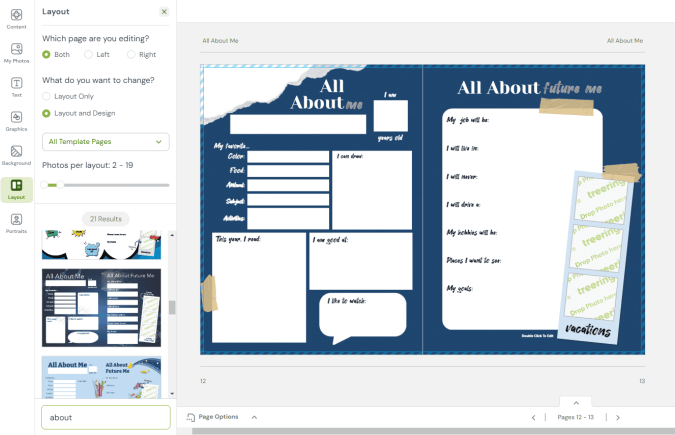
Pro tip: many Treering themes have these templates ready for you to drag onto a page.
Fill-in-the Blank Stories
Part 80s nostalgia, part English teacher ploy to get us to know our parts of speech, fill-in-the-blank stories can range from nonsensical to [fill in the blank]. 😉
We created one you can copy and paste for your yearbook.
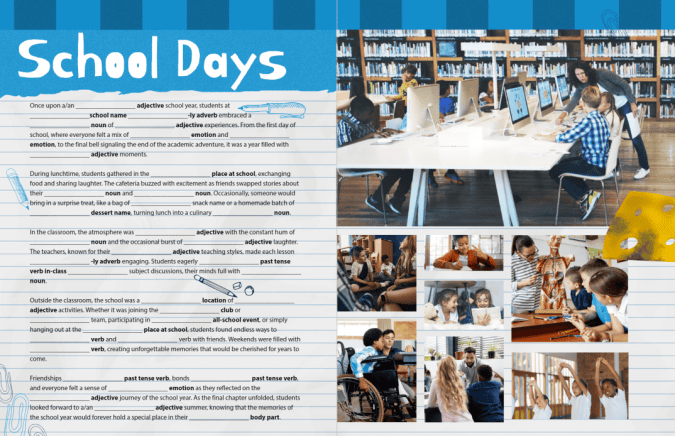
Puzzles
Including puzzles in a yearbook enhances personalization because they can play with words, images, and situations unique to your campus, fostering a sense of ownership. Simultaneously, these activities bring additional engagement into the yearbook, making the publication more dynamic. You can choose to add content with words and pictures.
Word Puzzles
Word searches, crossword puzzles, and the like add an entertaining interactive break from traditional pages. Additionally, for younger students, they can be a means to involve family members who may enjoy solving the puzzles with their child, creating another shared yearbook experience.
Include things in your puzzles such as school subjects and the
- Mascot
- School address (street and city)
- Special events or all-school activities
- Principal’s last name
- Names of clubs, teams, or electives
An online puzzle maker can help you customize an interactive puzzle.
People Matching
More fun than a history quiz, a yearbook matching module is a way to use your interactive content to increase coverage. Answers can share a page with the colophon.
Match
- Students to cars
- Baby photo to the students or teacher
- Teachers to their first job
- The cleat to the sport
- The fundraising total to the class
The easiest ask: pets.
Side note: maybe I should have titled this, “Gamify your yearbook.”
I Spy
There are two takes on this:
1. Search for objects such as eight basketballs, 14 pencils, and five nets. These items already exist within a section or the yearbook as a whole; you're just asking the student body to take a closer look.
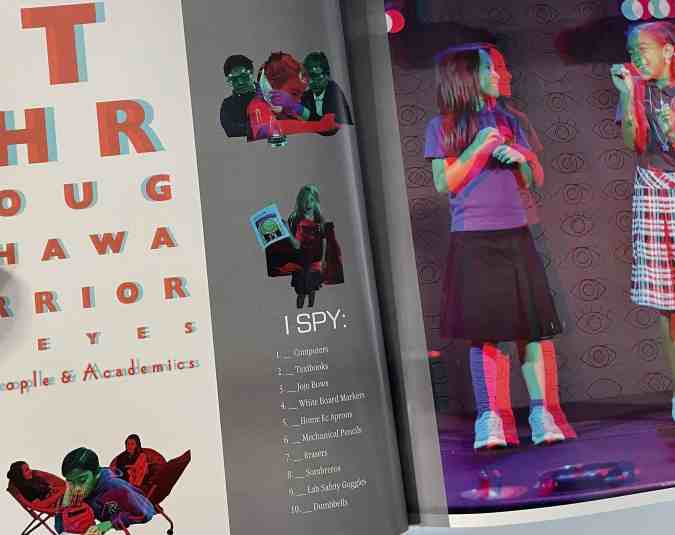
2. Find a person. This is the most labor-intensive: hide a COB of your mascot throughout the yearbook. (Yearbook Hero Katie Parish had a great take on this.)

Adding one or all four of these interactive yearbook page ideas gives students a place to reflect, share their “voice,” and foster a sense of community ownership of your collective narrative.

